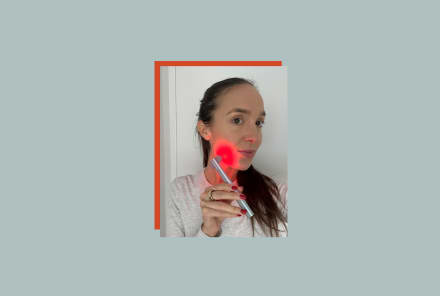Advertisement
Castile Soap Benefits & 14 Ways To Use It To Clean Every Room

Castile soap is a versatile cleaner that's handy to have around in your kitchen, bathroom, and everywhere in between. Its plant-based ingredients also make it a favorite among those who are looking to use natural, eco-friendly cleaning products in their homes.
For those thinking of picking up a bottle or bar, here's exactly what Castile soap is, how it differs from other cleaners, and 14 recipes to help you get the best use of it in every room.
What is Castile soap?
Castile soap gets its name from the Castilian region of Spain, where it was first created thousands of years ago. "Prior to Castile soap, soap was always made with animal fats," green living expert Lisa Bronner (yes, of Dr. Bronner's fame) tells mindbodygreen. The legend goes that it was Spanish Monastics who first swapped sheep and beef fat out for olive oil to create the first vegetable-based soap all those years ago.
Nowadays, "Castile is truly a multipurpose soap and very popular among people who want to live a cleaner, healthier, and more natural life," says Loni Brown, the founder and CEO of EntirelyEco. In addition to the original olive oil blend, you'll also find solid and liquid Castile soaps made with coconut oil, palm kernel oil, or hemp oil. "The term is now used a little more generally for a vegetable-based soap," says Bronner.
How the soap works.
All soap molecules have a water-loving head (sodium or potassium hydroxide) and a water-repelling tail (a fatty acid chain). This composition allows them to latch on to dirt and grime but still wash away in water. Soaps are created by combining a natural fat—in the cast of Castile, a vegetable oil—with a strong alkali in a process called saponification.
Over the past century, many soaps have been replaced by detergents, which are made from synthetic ingredients instead of vegetable or animal fats. Bronner notes that if you take a walk down a typical cleaning aisle, most of the bottles you see will be detergents.
Benefits of Castile soap.
Here are a few things that set Castile soap apart from other cleaners:
It's multipurpose.
Synthetic detergents tend to be very specialized: They're formulated with a specific job in mind, from giving glass a streak-free shine to getting stains out of clothing. Soaps, on the other hand, are more generalist products that can clean up a number of messes effectively.
This means that a high-quality Castile soap can replace dozens of other cleaning products, saving you some money, packaging waste, and storage space.
It's plant-based and cruelty-free.
Unlike animal-derived soaps, the oils in Castile soap come from plants that will naturally regenerate. And since it requires less land and water to raise a coconut than a cow, Castile soaps tend to be less resource-intensive to produce. And of course, no animals are harmed in the making of the product.
It's biodegradable.
Detergents can be made using any number of synthetic ingredients—some of which can pollute waterways1 when washed down the drain. This isn't a concern with Castile soap, as it's biodegradable and will completely break down in the environment within years. This makes it a popular choice among campers looking to leave no trace in the backcountry.
It's gentle on skin.
Since basic Castile soap (free of fragrances and dyes) is made from such simple ingredients, it's safe for most skin types. "It doesn't include harsh chemicals, petrochemicals, or preservatives," says Brown, making it a good choice for "people with highly sensitive skin and respiratory systems."
Bronner adds that unlike harsher products, plant-based soaps don't strip the skin of its beneficial natural oils. Castile soaps made with more moisturizing oils like coconut and jojoba tend to be the most nourishing for bath time.
It's customizable.
You can take unscented Castile soap up a notch by adding a few drops of your favorite essential oil(s). (But remember—less is more with these!) It's also easy to play around with the potency of liquid Castile. Most bottles contain a concentrated mix of soap that you can dilute to your liking depending on what you're looking to clean or wash.
It's easy to find.
"Castile soap is readily available from health food stores and online retailers," notes Jen Chillingsworth, author of the upcoming book Green Living: A Sustainable Guide to a More Intentional Life. She recommends looking for Castile soaps that are free of coloring, preservatives, or fragrances (other than essential oils).
Uses.
"Dirt and grime is pretty much the same everywhere, whether it's on our skin, on our counter, or on our clothes," Bronner reminds us. This raises the question: Why do we need a different type of cleaner for every surface?
In reality, we don't and would be better off using multipurpose cleaners like Castile all around our homes. Get started with these 14 room-by-room ideas.
Tips before getting started:
- Castile soap is a cleaner, not a disinfectant (there's a difference2!), and it won't kill bacteria or viruses at home.
- The concentration of Castile to water you use in these DIY recipes will depend on the soap brand, so be sure to always check the manufacturer's recommendations.
- You'll notice that none of these recipes directly mix Castile soap with vinegar or any other acid. These two cleaning agents will cancel each other out when combined.
- If you live in an area with hard water, beware that Castile soap might streak on your shinier objects like glass and cutlery, or leave your clothes with a filmy residue. Bronner explains that this happens because soap will naturally want to react with the minerals in hard water and leave a layer of soap scum behind. (Interestingly enough, this isn't an issue when using Castile soap on the body because of the pH level of our skin!)
You can find out if you have hard water using this quick, Bronner-approved trick:
Simply fill a glass with tap water and add a few drops of Castile soap. "If you can see the soap swirling and getting cloudy, that means it's reacting to the minerals and you have hard water. If you can see it sinking to the bottom pretty clear, that's soft water," Bronner says.
Hard-water folks can follow the recipe tweaks below to keep streaks to a minimum.
Kitchen:
An all-purpose surface spray.
Combine ¼ cup of Castile soap with 1 quart of distilled water in a spray bottle for a cleaner that can be used on all types of surfaces. Keep this one easily accessible so you can grab it in a pinch.
A countertop spray.
For stubborn countertop stains, first try treating with your all-purpose spray. If that doesn't do the job, Bronner recommends mixing baking soda and just enough water to form a paste. Let that sit on the stain for up to one day. Then, use a scraper to remove it and wash away any remaining residue using your Castile blend.
This should also work for sensitive soft stones like marble or limestone.
A dish soap.
Bronner likes to keep a foaming pump filled with one part Dr. Bronner's Castile soap with three parts water by her sink for a safe, effective dish cleaner. (You can either buy a new pump or reuse an old one after thoroughly cleaning and drying it.)
Brown notes that extra-greasy items will likely require a few extra pumps of the soapy mix. She especially likes using Castile on baby bottles, baby toys, pacifiers/teethers, etc., since it's so safe and gentle.
If you have hard water: To prevent streaks, dry your dishes by hand or dip your dishes into a vinegar rinse (a few dashes of distilled white vinegar in water) after washing them. "Any minerals brought out by the soap will be carried away by the vinegar," Bronner explains.
A dishwasher solution.
Place equal parts soap and water into your dishwasher dispenser. Brown notes that her dishes do come out clean with this method, though not as shiny as they might with a synthetic pod.
A fruit wash.
To wipe off any lingering dirt, pesticides, or pests from fresh produce, Bronner likes to rub them down with a pump of the dish soap blend. Rinse well before storing or eating.
Living room:
An upholstery cleaner.
Quickly wipe upholstery spills with a damp cloth. Then, spray your Castile all-purpose spray on the stain, and run your damp cloth over it again before letting it dry. "The key is you need to get all the soap out," says Bronner. "If you leave it, it will hold on to dirt, and stains will stick around."
A carpet cleaner.
Use the same process as you would for upholstery. Remember to act fast so the stain doesn't have time to settle in.
A houseplant leaf wash.
Wipe down your tropical plants' leaves with a solution of 1 tablespoon of Castile soap per quart of water to help prevent bugs and pests. Avoid desert varieties like cactuses, as they prefer dry leaves anyway.
Laundry:
A laundry detergent.
Place ¼ to ½ cup of Castile soap into the dispenser of your machine. Brown notes that this is an effective cleaner for all kinds of things, including bedding, towels, and delicates.
If you have hard water: Add ½ cup vinegar to the rinse cycle to wash away any lingering film.
A stain remover.
Place one to two drops of liquid Castile soap (or a swipe of solid Castile) directly onto stains and rub it in as a pretreatment. Let the garment soak in water before laundering.
Bathroom:
A body wash.
Castile soap is a gentle body wash that's safe for both adults and babies (Brown notes it's the only soap she used on her children until they were about 6 months old). Most people will be able to apply it directly, but those with very sensitive skin can dilute it in water before lathering up.
A shampoo.
Those with color-treated hair or hard water will want to avoid using Castile soap as a shampoo. For anyone else, it's fair game to lather up with a few drops of liquid Castile or a swipe of a Castile bar. Be aware that it likely won't foam up like shampoos that you're used to, and Brown notes that it is a little bit of an adjustment at first.
Castile soap is also safe to use on pet hair.
A shave cream.
Work a few drops of Castile soap into a lather in water and then apply and shave away.
A hand soap.
Dilute 2 tablespoons of liquid Castile soap into a cup of water and place in your sink-side dispenser. Chillingsworth adds that you can also keep a bar of solid Castile soap next to your bathroom and kitchen sink for handwashing.
A makeup brush cleaner.
Combine warm water and Castile soap into a gentle rinse for all your dirty brushes. Full recipe here.
The bottom line.
Castile soap is a simple yet versatile product that can be used a million (well, at least 14) ways at home. Swap it in for one of your harsher cleaners and you'll be well on your way to a safer, more eco-friendly sanctuary.
Watch Next
Enjoy some of our favorite clips from classes
Enjoy some of our favorite clips from classes
What Is Meditation?
Mindfulness/Spirituality | Light Watkins
Box Breathing
Mindfulness/Spirituality | Gwen Dittmar
What Breathwork Can Address
Mindfulness/Spirituality | Gwen Dittmar
The 8 Limbs of Yoga - What is Asana?
Yoga | Caley Alyssa
Two Standing Postures to Open Up Tight Hips
Yoga | Caley Alyssa
How Plants Can Optimize Athletic Performance
Nutrition | Rich Roll
What to Eat Before a Workout
Nutrition | Rich Roll
How Ayurveda Helps Us Navigate Modern Life
Nutrition | Sahara Rose
Messages About Love & Relationships
Love & Relationships | Esther Perel
Love Languages
Love & Relationships | Esther Perel

















